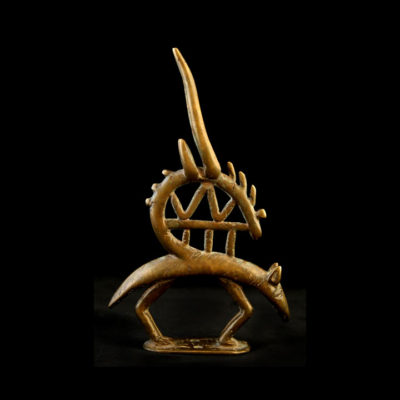
| SKU | CK.0060 |
|---|---|
| Circa | 20th Century AD |
| Dimensions | 5.5″ (14.0cm) high x 3.375″ (8.6cm) wide |
| Medium | Brass |
| Origin | Mali |
| Gallery Location | USA |
This appealing object is a miniature brass reinterpretation of the famous Bamana/Bambara Chiwara headdress. It has the traditional rounded head of the antelope, with ears and horns projecting almost vertically. Unusually, the piece is mounted on the back of an aardvark, which has significance for the Chi-Wara-Ton society as it is believed to best emblemise farmers owing to its habit of digging into soil. This is the first such piece that we have seen, and it was probably a personal talisman. A more general history of the Bamana and the Chiwara tradition is attached below.
The Bambara/Bamana are one of the largest groups in Mali (about 2.5 million) and lives in a savannah grassland area that contrasts strongly with the Dogon heartland. Their linguistic heritage indicates that they are part of the Mande group, although their origins go back perhaps as far as 1500 BC in the present-day Sahara. They gave rise to the Bozo, who founded Djenne in an area subsequently overrun by the Soninke Mande (<1100 AD). Their last empire dissolved in the 1600s, and many Mande speakers spread out along the Nigeria River Basin. The Bamana empire arose from these remnant populations in around 1740. The height of its imperial strength was reached in the 1780s under the rule of Ngolo Diarra, who expanded their territory considerably. Chiwara headcrests are the greatest achievement of the Bamana people, in terms of conceptualization, composition and abstraction. They were controlled and danced by the Chi-Wara-Ton society, which is – rarely for the Bamana – a society of both men and women who are charged with blessing the harvest. The name “chiwara” means “laboring wild animal” and refers to a half-man, half antelope that was born of Mousso Koroni (a sky goddess) and an earth spirit in the form of a cobra. Chiwara then taught the Bamana how to farm, and is worshipped accordingly. The headcrests are designed to represent the roan antelope, in varying degrees of abstraction. There are various styles, simplified into vertical, horizontal and abstract: these refer to the general orientation of the head and “horns”: of the antelope. The only commonality between representations is the pair of high horns, a head, and a zig-zag motif that is believed to represent the passage of the sun from east to west. They are also gendered: the presence of a baby antelope and straight horns indicates that the latter is female, while male versions have bent horns and a phallus. The shape of the body is designed to evoke the aardvark (who burrows into the soil as a good farmer should), the high horns resemble millet stalks, the penis of male figures usually touches the earth and thus symbolizes fertility, the baby on the back of the female represents Chiwara’s carrying of humans in order to teach them, and the ensemble is worn by a dancer who also wears a large costume made from raffia stalks that symbolize flowing water and good harvests. They are danced in male-female pairs to combine their fertility to best advantage. The dancers interact in a very specific way, the female fanning the male as he dances, in order to spread his power through the community. The male then acts like an antelope – scratching at the earth etc – before being shown the appropriate way to farm land. Different areas, carvers and workshops may produce widely variable final results that run the full gamut from relatively naturalistic to completely unrecognizable as anything connected with an antelope. Major regional variations include the Bougouni/Northern Style (abstracted multi-figural), the Bamako/Northern Style (specific horizontal style), the Segu/Northern Style (derived vertical style with cut-out triangular body motif) and the Sikasso style (with a thin, delicate, vertical form with a blunt, almost human face). This piece is technically carved in the Vertical /Segu/Northern Region style, as evidenced by the tall, vertical horns, ornate detailing and deliberate skewing of proportions. However, the association with the aardvark (?) makes it highly unusual. It is also a charming piece of Africana that would sit well in any collection or sophisticated domestic setting.
Login to view price
Sign-up to receive the latest Wedding Estates news and promotions!

